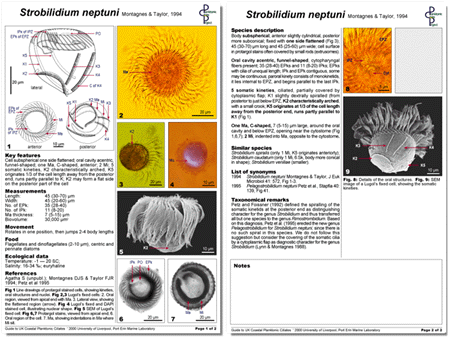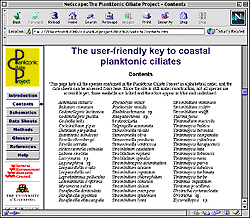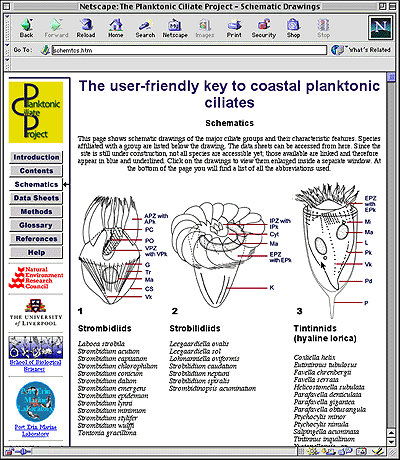The user-friendly guide to coastal planktonic ciliates
Instructions and Help
This web site is a quick reference for identifying planktonic ciliates. Since we are still collecting data and developing the web site, this guide is an incomplete beta-version. Data sheets will be added on a regular basis. Please check the list of species in the contents page regularly. The updates will also be announced via email. To subscribe to the mailing list send an email to ciliate@liv.ac.uk (comments, questions, contributions are welcome).
How to access information for a particular species
The guide provides several ways to help you identify ciliates in plankton samples.
1) If you do not know the genus or species:
Go to the schematics page, look at the generalised drawings, and find the most similar group. You
can then browse within this group by selecting a species and trying to identify your specimen. Additionally, you can compare
it with the similar species listed on the data sheets.
2) If you know the species or have an idea what it might be:
Go to the contents page and find the species; the link will lead to the data sheet. If the description
does not match the specimen you are looking at, you can always return to the generalised schematic drawings to find other
members of this group, or you can check the similar species listed on the data sheet.
3) If you just want a general indication of the species included in this web site:
Select data sheets and browse through them via the ‘next’ or ’previous’
buttons.
Components of the web site
The main section of this web site contains the data sheets, which give the taxonomic information for each species. Schematic drawings, pictures of Lugol’s fixed, DAPI- and protargol-stained cells, and scanning electron microscopy (SEM) images are used to present the species visually. As a start-up page for each species, the entire data sheet is shown.

This provides a holistic impression of the species. The text is divided into:
- key features
- measurements
- movement
- some ecological data (e.g. food, ranges of temperature and salinity )
- references to original papers
- a more detailed taxonomic description
- a list of similar species (linked to the particular data sheets)
- strictly taxonomic part (list of synonyms and remarks)
To enlarge and view the text or pictures on the data sheet, click on the specific area of the sheet. Each data sheet has a thumbnail picture (in the upper left corner) which links to the schematics page (see below), where the main characters of the species group are given and abbreviations are explained. The data sheets can be downloaded as high quality PDF files.
The contents section lists species in alphabetical order, and the data sheets can be accessed from there. The list of species is incomplete, as this site is constantly being updated.

The methods section briefly explains the common sampling, fixation, and staining techniques used for planktonic ciliates and gives references for further information.
In the schematics section, generalised schematic drawings of different ciliate groups are shown.

Each species is assigned to one of these groups - links from and to the data sheets are provided via the thumbnails on the data sheets and the species list under each schematic drawing. The characteristic features of the groups are shown in the drawings and the abbreviations of these features are explained on this page and linked to the glossary .
In the glossary we explain all terms in the descriptions and on the illustrations. Terms used in the illustrations and data sheets are linked to the glossary.
The reference section contains the bibliography for the whole web site. It includes all the references cited in the different sections, but is not linked to these pages.
For a better (faster) browsing experience, you might want to download the whole site compressed into a self extracting file which you then save to your harddrive and browse offline. This has the advantage of really fast rendering of pages but has the disadvantage of a very long download time (though only once), of up to 4-8 hours, depending on the speed of your internet connection. You should subscribe to our mailing list to be informed of updates and changes to the site. Whenever there is an update or a change, the whole-site-file will be updated as well. Depending on your preferences you can then decide whether you want to download the updated self-extracting file all over again or whether you can do with the previous version and wait for the next major update. Download Ciliate website.exe (52.4 MB). This file will install a folder called "Ciliate website" on your hard drive.
If problems occur, please contact us through the following email address: ciliate@liv.ac.uk
[Printversion] [Copyright] [Home]









